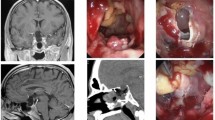Abstract
Purpose
The transsphenoidal approach (TSA) is regarded as the first line of treatment for sellar and suprasellar lesions. There are only few case reports of postoperative subdural hematoma after TSA and extended transsphenoidal approach (eTSA), and the detailed incidence and risk factors for this complication are still unknown. We reviewed the incidence and risk factors for subdural hematoma after TSA and eTSA.
Methods
Between January 1, 2013 and December 31, 2014, 165 consecutive patients underwent TSA or eTSA at Nagoya University Hospital and Nagoya Daini Red Cross Hospital. Fifty-one patients experienced intraoperative CSF leakage. Postoperative subdural hematoma was observed in 10 patients, all of whom experienced intraoperative CSF leakage. We reviewed clinical data including CT and MR images and examined factors related to subdural hematoma among patients with intraoperative CSF leakage.
Results
In univariate statistical analyses, risk factors for postoperative subdural hematoma were advanced age, high Evans’ index, and preoperative hypopituitarism. These factors were also significant in the multivariate logistic regression analysis. There were no statistical differences in sex, tumor size, approach methods, preoperative diabetes insipidus, or degree of intraoperative CSF leakage.
Conclusions
The incidence of postoperative subdural hematoma after intraoperative CSF leakage during TSA and eTSA was higher than the incidence reported in patients after craniotomy. Intraoperative CSF leakage should be avoided as much as possible, especially in patients with brain atrophy and/or enlargement of the ventricular system, even if the intent of the reconstruction technique is authenticity. In addition, patients with hypopituitarism should be carefully followed up after surgery.



Similar content being viewed by others
References
Kassam AB, Prevedello DM, Carrau RL, Snyderman CH, Thomas A, Gardner P, Zanation A, Duz B, Stefko ST, Byers K, Horowitz MB (2011) Endoscopic endonasal skull base surgery: analysis of complications in the authors’ initial 800 patients. J Neurosurg. doi:10.3171/2010.10.JNS09406
Takeuchi K, Nagatani T, Wakabayashi T (2015) How I do it: shoelace watertight dural closure in extended transsphenoidal surgery. Acta Neurochir (Wien). doi:10.1007/s00701-015-2612-4
Wormald PJ, McDonogh M (2003) The bath-plug closure of anterior skull base cerebrospinal fluid leaks. Am J Rhinol 17:299–305
Hu F, Gu Y, Zhang X, Xie T, Yu Y, Sun C, Li W (2014) Combined use of a gasket seal closure and a vascularized pedicle nasoseptal flap multilayered reconstruction technique for high-flow cerebrospinal fluid leaks after endonasal endoscopic skull base surgery. World Neurosurg. doi:10.1016/j.wneu.2014.06.004
Hadad G, Bassagasteguy L, Carrau RL, Mataza JC, Kassam A, Snyderman CH, Mintz A (2006) A novel reconstructive technique after endoscopic expanded endonasal approaches: vascular pedicle nasoseptal flap. Laryngoscope. doi:10.1097/01.mlg.0000234933.37779.e4
Leng LZ, Brown S, Anand V, Schwartz T (2008) “Gasket-seal” watertight closure in minimal access endoscopic cranial base surgery. Neurosurgery. doi:10.1227/01.NEU.0000312720.93685.17
Inamasu J, Watabe T, Ganaha T, Yamada Y, Nakae S, Ohmi T, Imizu S, Kaito T, Ito K, Nishiyama Y, Hayashi T, Sano H, Kato Y, Hirose Y (2013) Clinical characteristics and risk factors of chronic subdural haematoma associated with clipping of unruptured cerebral aneurysms. J Clin Neurosci. doi:10.1016/j.jocn.2012.09.024
Ohno T, Iihara K, Takahashi JC, Nakajima N, Satow T, Hishikawa T, Nagata I, Yamada K, Miyamoto S (2013) Incidence and risk factors of chronic subdural hematoma after aneurysmal clipping. World Neurosurg. doi:10.1016/j.wneu.2012.09.025
Eloqayli H, Cappelen J, Vik A (2006) Acute spontaneous subdural haematoma after transsphenoidal surgery. Acta Neurochir (Wien). doi:10.1007/s00701-005-0699-8
Okada MY, Fukuhara N, Nishioka H, Yamada S (2014) Remote extradural haematomas following extended transsphenoidal surgery for a craniopharyngioma—a case report. Br J Neurosurg. doi:10.3109/02688697.2014.899314
Tanaka Y, Kobayashi S, Hongo K, Tada T, Kakizawa Y (2002) Chronic subdural hematoma after transsphenoidal surgery. J Clin Neurosci. doi:10.1054/jocn.2001.0956
Yuan W (2013) Managing the patient with transsphenoidal pituitary tumor resection. J Neurosci Nurs. doi:10.1097/JNN.0b013e3182828e28
Esposito F, Dusick JR, Fatemi N, Kelly DF (2007) Graded repair of cranial base defects and cerebrospinal fluid leaks in transsphenoidal surgery. Neurosurgery. doi:10.1227/01.NEU.0000255354.64077.66
Synek V, Reuben JR, Du Boulay GH (1976) Comparing Evans’ index and computerized axial tomography in assessing relationship of ventricular size to brain size. Neurology 26:231–233
Kanda Y (2013) Investigation of the freely available easy-to-use software “EZR” for medical statistics. Bone Marrow Transplant. doi:10.1038/bmt.2012.244
Halvorsen H, Ramm-Pettersen J, Josefsen R, Rønning P, Reinlie S, Meling T, Berg-Johnsen J, Bollerslev J, Helseth E (2014) Surgical complications after transsphenoidal microscopic and endoscopic surgery for pituitary adenoma: a consecutive series of 506 procedures. Acta Neurochir (Wien). doi:10.1007/s00701-013-1959-7
Menon G, Bahuleyan B, Nair S (2009) Acute subdural hematoma after transsphenoidal surgery. J Clin Neurosci. doi:10.1016/j.jocn.2008.04.012
Frank G, Pasquini E, Doglietto F, Mazzatenta D, Sciarretta V, Farneti G, Calbucci F (2006) The endoscopic extended transsphenoidal approach for craniopharyngiomas. Neurosurgery. doi:10.1227/01.NEU.0000219897.98238.A3
De Divitiis E, Cappabianca P, Cavallo L, Esposito F, de Divitiis O, Messina A (2007) Extended endoscopic transsphenoidal approach for extrasellar craniopharyngiomas. Neurosurgery. doi:10.1227/01.NEU.0000280113.98151.24
Quintana LM (2013) Chronic subdural hematoma after neurosurgical procedures. World Neurosurg. doi:10.1016/j.wneu.2012.11.015
Mori K, Maeda M, Maas A, Dunn L (2003) Risk factors for the occurrence of chronic subdural haematomas after neurosurgical procedures. Acta Neurochir (Wien). doi:10.1007/s00701-003-0026-1
Franchini M, Lippi G, Manzato F, Vescovi PP, Targher G (2010) Hemostatic abnormalities in endocrine and metabolic disorders. Eur J Endocrinol. doi:10.1530/EJE-09-0958
van Asch CJ, Luitse MJ, Rinkel GJ, van der Tweel I, Algra A, Klijn CJ (2010) Incidence, case fatality, and functional outcome of intracerebral haemorrhage over time, according to age, sex, and ethnic origin: a systematic review and meta-analysis. Lancet Neurol. doi:10.1016/S1474-4422(09)70340-0
Hsieh JT, Ang BT, Ng YP, Allen JC, King NKK (2016) Comparison of gender differences in intracerebral hemorrhage in a multi-ethnic Asian population. PLoS ONE. doi:10.1371/journal.pone.0152945
Author information
Authors and Affiliations
Corresponding author
Ethics declarations
Conflict of interest
The authors declare that they have no conflict of interest.
Rights and permissions
About this article
Cite this article
Takeuchi, K., Watanabe, T., Nagatani, T. et al. Incidence and risk factors of subdural hematoma after intraoperative cerebrospinal fluid leakage during the transsphenoidal approach. Pituitary 19, 565–572 (2016). https://doi.org/10.1007/s11102-016-0746-x
Published:
Issue Date:
DOI: https://doi.org/10.1007/s11102-016-0746-x




